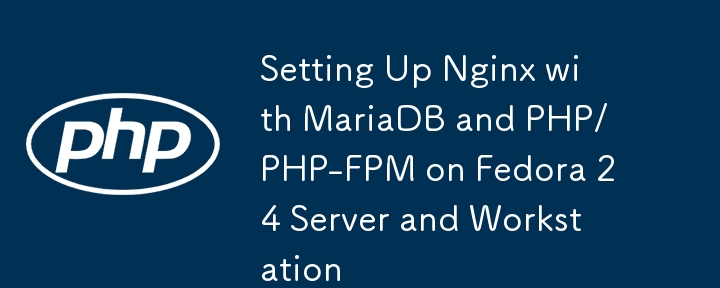

Das Hosten von Websites und Online-Anwendungen erfordert die Einrichtung einer Webserver-Infrastruktur. In diesem Artikel versuchen wir, die Einrichtung von Nginx auf Fedora 24 Server und Workstation mit MariaDB und PHP/PHP-FPM zu verstehen. Diese Kombination schafft einen starken Stack für die Verwaltung von Datenbanken und die Präsentation dynamischer Inhalte. Die hier behandelten Hauptkonzepte können auf nachfolgende Versionen von Fedora oder anderen Linux-Distributionen angewendet werden, auch wenn Fedora 24 eine ältere Edition ist.
Fedora 24 Server wurde mit dem Linux-Kernel erstellt, der als Grundlage des Betriebssystems dient. Der Linux-Kernel bietet wichtige Funktionen wie Gerätetreiber, Speicherverwaltung, Prozessverwaltung und Hardwareunterstützung.
Serverorientierte Pakete − Die Fedora 24 Server Edition enthielt eine Reihe serverorientierter Pakete, mit denen Benutzer eine Reihe von Serverdiensten und -anwendungen konfigurieren und steuern können. Zu diesen Paketen gehörten E-Mail-Server, Webserver, Datenbankserver und mehr.
DNF-Paketmanager − DNF (Dandified Yum) diente als Standardpaketmanager von Fedora 24 Server. Es bot eine Befehlszeilenschnittstelle zum Installieren, Entfernen und Aktualisieren von Systemen. Im Vergleich zu Yum bietet DNF eine bessere Geschwindigkeit und Abhängigkeitsauflösung.
Serverrollen − Mit der Einführung von Serverrollen in Fedora 24 Server konnten Benutzer nun bei der Installation bestimmte Serverkonfigurationen auswählen. Verschiedene Servertypen, darunter Dateiserver, Datenbankserver, Domänencontroller und Webserver, wurden von diesen Rollen abgedeckt, die auch vordefinierte Softwarepakete und Einstellungen bereitstellten.
Fedora 24 Server führt die webbasierte Verwaltungsoberfläche Cockpit ein, die entwickelt wurde, um Serververwaltungsaufgaben zu erleichtern. Mit Cockpit können Benutzer einen Webbrowser verwenden, um Systemdienste zu verwalten, die Systemleistung zu verfolgen, Netzwerke einzurichten und einfache Verwaltungsaufgaben auszuführen.
Sicherheit und Community-gesteuerte Entwicklung − Durch die Einbeziehung der neuesten Sicherheitspatches und -upgrades hat Fedora 24 Server Stabilität und Sicherheit an die erste Stelle gesetzt. Die Distribution profitierte von einer florierenden und aktiven Community, die als Mitglied des Fedora-Projekts an der Entwicklung, dem Testen und der Verbesserung beteiligt war.
Fedora-Ökosystem − Fedora 24 Server war neben Fedora Workstation und Fedora Atomic eine von mehreren Versionen, die das breitere Fedora-Ökosystem bildeten. Vom Desktop-Computing bis hin zu Cloud- und Serverinstallationen wollte das Ökosystem eine Vielzahl von Lösungen für verschiedene Anwendungsfälle bieten.
Fedora 24 erleichtert auch die Nutzung des Nginx-Webservers, da es als Paket in sein offizielles Repository aufgenommen wird. Nginx erfreut sich auch aufgrund seiner leistungsstarken, leichten und effizienten Architektur großer Beliebtheit. Über die Konvergenz dieser beiden Plattformen wird in diesem Artikel gesprochen.
Es ist wichtig zu bedenken, dass Fedora-Versionen normalerweise nur für einen Zeitraum von 13 Monaten Support erhalten. Aus diesem Grund werden für Fedora 24 Server offiziell keine Updates und Sicherheitsfixes mehr bereitgestellt. Für Serverinstallationen wird empfohlen, eine neuere Version von Fedora zu verwenden oder nach anderen Linux-Distributionen zu suchen, die eine langfristige Wartung bieten.
Verwenden des LEMP-Stack-Installationsskripts
Manuelle Installation
The installation and configuration of the LEMP stack (Linux, Nginx, MySQL/MariaDB, PHP/PHP-FPM) on a Linux server is automated using the LEMP stack installer script. By taking care of the necessary software component installation and configuration automatically, this script makes it easier to deploy the LEMP stack.
A third-party company or an open-source community normally creates and maintains the LEMP stack installation script. It seeks to speed up the installation procedure and provide uniform configuration across various platforms. The script often comes with preset configurations and best practice-based optimizations.
Initiate by installing nginx on Fedora 24 and proceed with the nginx service
sudo dnf install nginx sudo systemctl start nginx
Install MariaDB and start the service.
sudo dnf install mariadb-server sudo systemctl start mariadb
Install PHP an dPHP-FPM on Fedora 24 using the command and start its service as well.
sudo dnf install php php-fpm sudo systemctl start php-fpm
Download the LEMP Stack Installer script with the help of the given code. Make the Script executable and then run the script.
wget https://raw.githubusercontent.com/rtCamp/easyengine/master/services/nginx/install.sh sudo chmod +x install.sh sudo bash install.sh
Test the full setup, if it's working correctly.
In order to manually install Nginx with MariaDB and PHP/PHP-FPM on Fedora 24 Server and Workstation, each component must first be installed and then configured to function together.
Install the pre- requisites, like we did in the previous method:(Install nginx, MariaDB, PHP and PHP-FPM.
Configure nginx to work with PHP-FPM using the given series of code
sudo nano /etc/nginx/nginx.conf
server {
location ~ \.php$ {
fastcgi_pass unix:/var/run/php-fpm/php-fpm.sock;
fastcgi_param SCRIPT_FILENAME $document_root$fastcgi_script_name;
include fastcgi_params;
}
}
Save the file and test the configuration of nginx.
Check the PHP information page to see the PHP installation details.
You can also perform additional configurations, this is optional but will make it work to your specific requirement.
In conclusion, setting up Nginx, MariaDB, and PHP/PHP-FPM on Fedora 24 Server and Workstation produces a dynamic web server environment that can handle databases.
Following the manual installation process outlined in this article will enable you to appropriately configure each component and build a dependable infrastructure for hosting websites and online applications.
The manual installation technique entails installing and configuring each component one at a time in order to guarantee proper compatibility. The web server is set up using Nginx and ready to receive incoming requests. A security configuration has been made for the database management system MariaDB. Nginx can run PHP scripts since PHP/PHP-FPM is installed and integrated.
While working with Fedora 24, it should be kept in mind that it is an outdated version, which no longer is updated or fixed. It is strongly advised to use recent versions which receive security fixes or other Linux distributions for the better security of your data and compatibility of the device.
In conclusion, Fedora 24 may be set up manually or using the installer script to provide a reliable web server environment that can be used to host dynamic websites, develop online applications, and effectively manage databases.
Das obige ist der detaillierte Inhalt vonEinrichten von Nginx mit MariaDB und PHP/PHP-FPM auf Fedora 24 Server und Workstation. Für weitere Informationen folgen Sie bitte anderen verwandten Artikeln auf der PHP chinesischen Website!




